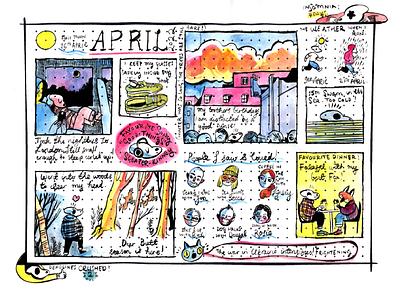Looking for all Articles by Candice Purwin?
Journaling for wellbeing
Candice Purwin shares her experience and advice on journaling through comics

As an illustrator and animator, I have always used sketchbooks to draft work, record ideas or draw for the sheer joy of it in a place I can revisit. I initially studied film at Napier University in Edinburgh, a city I kept returning to until settling here in 2018, and I think it was this love of film making that later drew me to comics. They were like little movies I could make in my room by myself with no practical constraints on my imagination.

An avatar
When I first started writing comics I drew a little character who was almost, but not quite, me. Journaling as someone else helped me to say and be things other than myself, which is fun and sometimes necessary if I'm writing about difficult topics. It also helped me not to be too strict about getting my drawing 'right'. I didn't learn to draw people until a lot later. Cartoon animals and monsters were always easier and more expressive than humans and they were never expected to look like anyone but themselves.
These creations develop voices of their own too, if you let them, and can see things in ways you wouldn't expect (even though everything is happening in your own brain. It's wild!)

Scribbles to fight sadness
I have always kept a diary or a sketchbook in one way or another. As an adult, when I started trying to manage feelings of depression and deep melancholy I kept a little book that just recorded when I got my period and how I felt in the days leading up to it. Single words and short sentences to say when I couldn't sleep or concentrate, when I felt very bad and when I began to feel better. Sometimes the depression was linked to my cycle and sometimes it was a separate beast. I have always taken long walks in cities and the countryside when I need time to think and the weather, the sky, the people I met and what I was thinking about also began to make their way into these monthly notes until they demanded time and space of their own.

Diary comics
I usually have two sketchbooks in use at once. One is very little and I try to make a drawing daily or every few days. If I overthink this or leave it too long it's hard to get started again, but when I get a good run of tiny notes and pictures, it's a very satisfying thing to look back at. It also builds a good foundation for other drawing and writing and is an excellent place to recognise patterns, either in myself or what I am seeing around me. The other sketchbook is A4 or A5 and will contain larger drawings and experiments with words, lines, ink and colour and full drafts of new comics. Here the words part ways with the pictures they were originally illustrating and unexpected stories emerge. This is one of the most powerful things about panelled storytelling and a fun thing to experiment with when you're working through your journals.